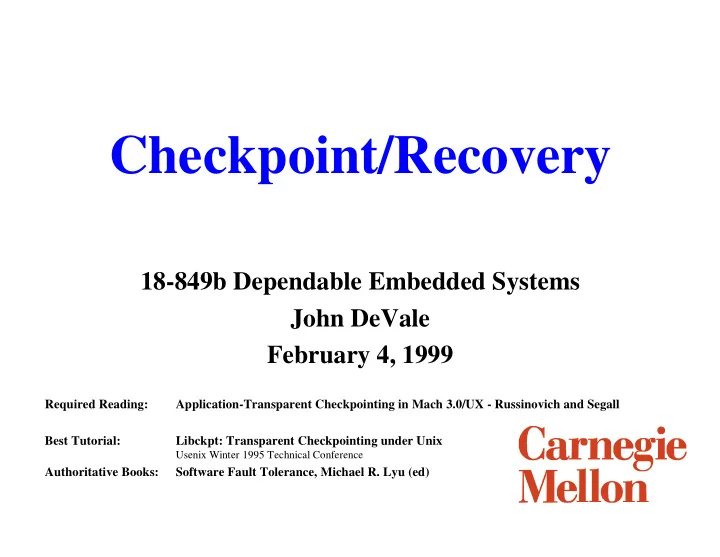

Checkpoint/Recovery 18-849b Dependable Embedded Systems John DeVale February 4, 1999 Required Reading: Application-Transparent Checkpointing in Mach 3.0/UX - Russinovich and Segall Best Tutorial: Libckpt: Transparent Checkpointing under Unix Usenix Winter 1995 Technical Conference Authoritative Books: Software Fault Tolerance, Michael R. Lyu (ed)
Overview: Checkpointing - Recovery N Introduction • Method of creating fault tolerant software systems N Key concepts • Periodically saves process/system state • In the event of a fault, state is restored via a rollback • Scales to distributed/parallelized applications N Tools / techniques / metrics • Stratus VOS and Tandem NonStop Kernel • libFt , libckpt N Relationship to other topics • Fault Tolerant Computing technique N Conclusions & future work 2
Checkpoint - Recovery… The basic picture Memory Non-Volatile Checkpoint mechanism copies the state of Copy of Process A Process A process A into non- volatile storage System Failure... Restore mechanism copies the last known checkpointed Memory Non-Volatile state of process A back into memory and continues Restored processing. This Copy of Copy of mechanism is especially Process A Process A useful for application which may run for long periods of time before reaching a solution. 3
Where we are 4
Description of Topic N Checkpoint-Recovery gives an application or system the ability to save its state, and tolerate failures by enabling a failed executive to recover to an earlier safe state. N Key ideas • Saves executive state • Provides recovery mechanism in the presence of a fault • Can allow tolerance of any non-apocalyptic failure • Provides mechanism for process migration in distributed systems for fault tolerance reasons or load balancing 5
Saves Executive State N When a checkpoint is executed, a snapshot of all program state is saved into some non-volatile, machine accessible medium. • Time • Space • Memory Exclusion - new idea – Ref:Memory Exclusion: Optimizing the Performance of Checkpointing Systems James Plank, submitted for publication, SP&E – Allows the checkpointing mechanism to be told, and/or dynamically determine what memory structures are an important part of program state, and only save those structures. – Saves time AND space 6
Provides Recovery Mechanism N Once a fault has occurred, the recovery mechanism restores the program to the last checkpointed state • Current automatic Unix based tools wait for the process to abort, and restore it after abort. – Time constraint may not allow for this length of recovery – In the presence of a software design fault, rollback mechanism needs more complexity to allow rollback to a previous state, yet retain knowledge of faulted path of execution. • Stratus, Tandem seem to handle this, but details are sketchy 7
Failure Tolerance N Faults can be tolerated, even those which may physically destroy the processing site • Geographically distant sites with a synchronized distributed systems can perform coordinated checkpoints and process migration. • Transient faults and glitches tolerated as a matter of course through the normal checkpoint-recovery system 8
Tools / Techniques N libFT - AT&T research labs • Provides checkpoint recovery and watchdog demons • http://www.research.att.com/sw/tools/reuse/packages/ft.html N libCKPT - University of Tenn. Knoxville • Provides incremental checkpoint recovery library, with memory exclusion • http://www.cs.utk.edu/~plank/plank/www/libckpt.html N PMCKPT • The Poor man’s checkpoint • http://warp.dcs.st-andrews.ac.uk/warp/systems/checkpoint/source.html N CONDOR • Process migration for load balancing • http://www.cs.wisc.edu/condor N General Links • http://warp.dcs.st-andrews.ac.uk/warp/systems/checkpoint/ 9
Metrics N Key Metrics in Checkpoint - Recovery • Snapshot Time – How long it takes to identify and copy (to intermediate storage) all required program state • Commit Time – How long it takes to copy snapshot into non-volatile storage • Recovery Time – How long it takes to restore state to a failed process N Dependant on state size and system performance 10
Relationship To Other Topic Areas N Fault Tolerant Computing • Checkpoint - Rollback is a technique which can be used to build fault tolerance into a computing system • In its current form it very capably saves process state and can create a new process and restore old state to it in the case of a process failure N SW fault tolerance • Related to SW fault tolerance by sharing a common goal • Scope of the solutions are on a much different scale – SW fault tolerance focuses more on making software not crash – Traditional checkpointing focuses on recovering from the crash in a graceful manner while preserving computational state and critical data. 11
Conclusions & Future Work N Checkpoint-Recovery provides • Ability to save and restore state for critical applications • Useful for single computer systems and large distributed or parallel systems • Can incur large time penalties during checkpointing N Future Work • Design for Checkpoint-Recovery – Design critical systems to have as small a critical state as possible » Breakdown task into smaller subsystems which can be checkpointed separately » Self recovering state • Task restart may not be possible in small RT/Embedded systems – Support at the OS level to allow micro checkpoints and rollbacks at a task level 12
Application-Transparent Checkpointing in Mach N Paper presents methodology for checkpoint-recovery N Performance varied with memory footprint • Typically <5 sec checkpoint cost (first) less for subsequent • Larger commit delays - 10 to 30 sec of degraded performance • Recovery times 5 to 10 sec for reasonably sized applications N Major Contributions • Provides roadmap on how one might build in transparent checkpointing • Can checkpoint and restore entire system state in X N Limitations • Time costly • Requires custom pager in OS • Does not address memory exclusion (trade-off for transparency) 13
Recommend
More recommend